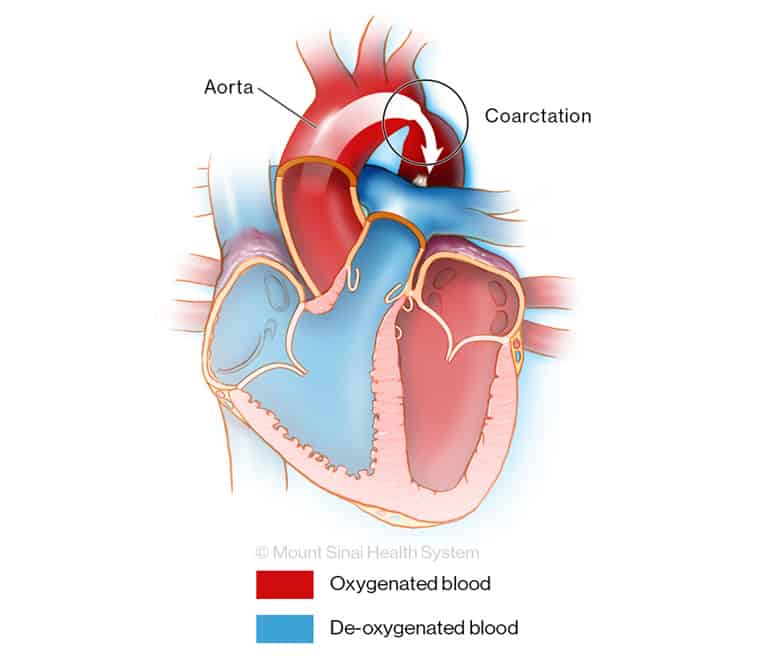Coarctation of the Aorta
Mount Sinai Kravis Children’s Heart Center is here to treat your child with coarctation of the aorta. We start by helping you face the frightening news that your child has a congenital heart defect. As we diagnose and treat your child, we explain the condition and discuss with you how our experienced and compassionate team of pediatric cardiology specialists can help every step of the way.
About Coarctation of the Aorta
Coarctation of the aorta is a congenital heart disease (present at birth) with narrowing of the aorta—the major blood vessel that carries oxygenated blood from the heart to the body. If the narrowing (coarctation) of the aorta is severe, it may cause damage to the heart, high blood pressure in the heart and brain, and affect the organs in the lower body that don't get enough oxygenated blood.

Symptoms
Symptoms of coarctation of the aorta depend on its severity and your child’s age.
Your newborn may become sick with the following symptoms if the obstruction is severe:
- Labored or rapid breathing
- Weak femoral artery pulse (taken in the groin area)
- Pale or gray appearance
Your older child, adolescent, or even an adult may develop symptoms later in life, such as:
- Weak femoral (leg) pulses
- High blood pressure (hypertension) in the arms
- Heart murmur
- Difficulty exercising (gets out of breath quickly)
- Headaches
Diagnosis
To diagnose your child’s coarctation of the aorta accurately, we may perform a combination of the following tests:
- Echocardiogram—a safe, noninvasive procedure that uses ultrasound waves to create an image of the size, shape, and movement of your child’s heart, valves, and chambers along with how blood flows (also called an echo or cardiac ultrasound)
- Electrocardiogram (ECG)—a noninvasive procedure that shows electrical activity by placing stickers on your child’s chest
- Chest X-ray— takes pictures of your child’s heart, lungs, and blood vessels, and can show if the heart is enlarged
- Pulse oximetry—a noninvasive way to monitor the oxygen content of your child’s blood without drawing blood
- Blood pressure measurements—uses safe, noninvasive inflatable cuffs on the arms and legs
- Cardiac MRI—uses safe, powerful magnets and radio waves to create pictures of your child’s heart
- Cardiac catheterization—minimally invasive procedure for diagnosis and sometimes treatment. Involves inserting a thin tube into the affected area to measure blood flow and pressure in the heart to determine severity of condition and if treatment is needed
Treatments We Offer
The treatment your child needs will depend on how serious the condition is. Mild cases of coarctation of the aorta may only require regular supervision. However, if your child’s obstruction is serious, it will require repair.
Medication
If your newborn is diagnosed with a critical obstruction, we will start treatment with an IV to give your child medicine called prostaglandin. A continuous dose of prostaglandin keeps open the blood vessel (patent ductus) that all babies are born with. This will maintain blood flow to the lower half of your baby’s body while your doctors prepare for the next step in treatment.
Sometimes after the coarctation is repaired, your child may still have high blood pressure, especially if the obstruction was severe for a long time. Fortunately, we can use medication to lower your child’s blood pressure.
Surgery
The best treatment for your child’s condition may be heart surgery. Surgery improves blood flow across the aorta and heals the obstruction. First, we will ensure that your child is stabilized and ready for an operation. Then our pediatric cardiac surgeon will operate to remove the narrow section of the aorta or to enlarge the aorta with a patch.
Cardiac catheterization
In some cases, usually in older children, we can open a narrowed segment of the aorta with heart catheterization (a thin flexible tube inserted into the heart through an artery). Our interventional cardiologist will open that area by briefly inflating a balloon. Typically, we also place a stent in the aorta to prop open the area. As your child grows, this stent may need to be stretched larger through a similar procedure.
No matter what procedure your child undergoes, lifelong follow-up is advised to monitor the area of repair. Long-term issues that we watch your child for also include hypertension (high blood pressure) which sometimes requires treatment with medications.
Why Choose Children’s Heart Center?
Our pediatric cardiologists have extensive experience in diagnosing and treating congenital heart disease including coarctation of the aorta, with special expertise in complex and high-risk cases. We provide highly personalized and innovative care for your child as we advise and comfort you and your family, before, during, and after treatment.